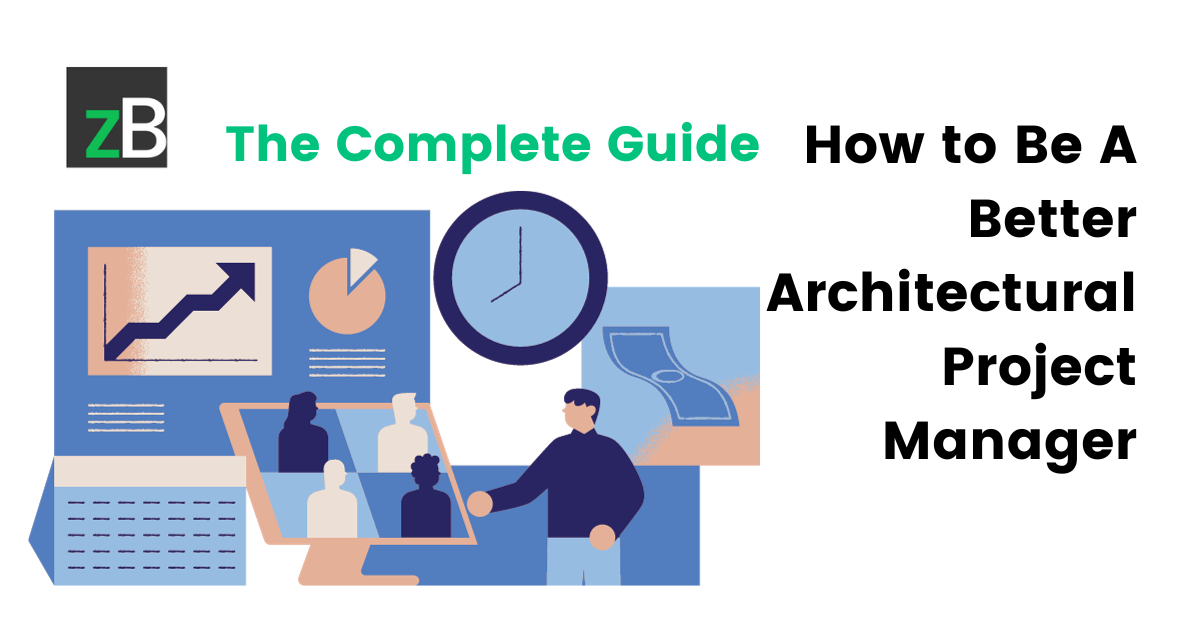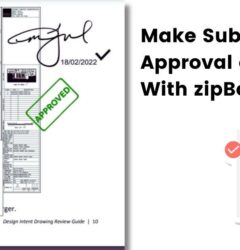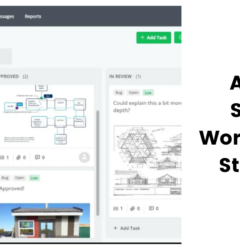How to Be A Better Architectural Project Manager: The Complete Guide
27 Oct

Table of Contents
ToggleWondering how to get started in architecture project management or be a better architectural project manager? You’re not alone. Many architects face the same challenge considering your training is primarily in design and architecture, not project management.
But this guide will provide you with the necessary resources to get started in project management or get better at what you’re already doing. We’ll cover core responsibilities, essential skills, tools, strategies, and career development opportunities to enable you to excel and drive success in the projects you manage.
Architectural project management is all about knowing what the end product – end result – is supposed to be and being very deliberate about the steps to get there. You need to have the finished thing in mind.
MIKE BAHR, AIA, PARTNER & DIRECTOR OF CLIENT RELATIONS, PLUNKETT RAYSICH ARCHITECTS, LLP
Who is an Architectural Project Manager?
An Architectural Project Manager is a professional in the architecture industry (usually an architect), responsible for overseeing various aspects of a project, and ensuring it runs smoothly from inception to completion.
This person serves as a bridge between the design team, construction crew, clients, and other stakeholders. It is, however, worth mentioning that a project manager in architecture isn’t always an architect.
Project management in architecture doesn't necessarily have to be done by an architect. A good project manager in our field understands architecture. But the world of project management doesn't necessarily mean you have to understand mechanical systems and how masonry cladding is attached, or things that an architect would have to understand. The project manager has to be able to count on the architect to know those things and use them when it's time.
Doug Kunde, AIA - Project Manager & Associate at Plunkett Raysich Architects
The role of an architectural project manager demands a blend of skills, from technical expertise to soft skills like communication and leadership capabilities.
To excel as a project manager, you must continuously adapt, learn, and navigate the challenges that come with managing people and complex projects. These will help you define and manage project scope, budget, and schedule (the 3 pillars of project management).
What are the Job Responsibilities of an Architectural Project Manager?
The role of an Architectural Project Manager is multifaceted and involves a wide range of responsibilities, including:
1. Project Planning and Initiation: Defining project objectives, creating comprehensive project plans, and assembling teams with clearly defined roles and responsibilities.
2. Budget Management: Developing and managing project budgets, monitoring expenses, preparing cost estimates, and making financial forecasts to ensure cost control.
3. Resource Allocation: Allocating resources, including labor, materials, and equipment while optimizing their utilization to meet project goals effectively.
4. Quality Control: Establishing and maintaining quality standards, monitoring construction or design processes for compliance, and implementing quality assurance and control procedures.
5. Risk Management: Identifying potential risks and developing mitigation strategies. Additionally, you’ll implement risk management plans to minimize project disruptions.
6. Project Scheduling: Developing and maintaining project schedules, ensuring team members complete tasks on time. You’ll also adjust schedules to accommodate changes.
7. Team Leadership: Leading and motivating project teams, fostering collaboration and productivity. Furthermore, your tasks will include providing guidance and support to team members.
8. Communication: Maintaining clear and open lines of communication with all project stakeholders, including clients, team members, and contractors. Regular project progress updates will also be part of your role.
9. Contract Management: Reviewing and negotiating contracts with vendors and subcontractors to ensure contract compliance. You’ll also manage contractual relationships.
10. Regulatory Compliance: Ensuring that the project adheres to all relevant building codes and regulations, and obtaining necessary permits and approvals.
11. Problem-Solving: Addressing unexpected challenges and resolving issues as they arise, as well as making critical decisions to keep the project on track.
12. Documentation: Maintaining accurate project records and documentation, preparing reports, and creating presentations for stakeholders.
13. Client Relations: Building and maintaining strong client relationships, understanding and meeting client expectations, and aligning project goals with client needs.
14. Health and Safety: Promoting and enforcing safety protocols on the project site and ensuring the well-being of all workers and stakeholders.
15. Project Closure: Finalizing all project activities, documentation, and financial settlements. You’ll also conduct post-project evaluations to identify lessons learned for future improvements.
Educational Requirements and Training for Architectural Project Managers
In the video below, you’ll find that you may not always need formal education in project management to be a project manager in the architecture industry. However, formal education, professional trainings, and certifications can get your foot in the door.
1. Educational Background and Degrees: To embark on a career as an Architectural Project Manager, a strong educational foundation is usually required. Most individuals in this role possess at least a Bachelor’s degree in a relevant field. Below are 3 common degree programs:
- Bachelor of Architecture (B.Arch)
- Bachelor of Science in Construction Management
- Bachelor of Science in Civil Engineering
2. Relevant Certifications and Licenses: In addition to formal education, many Architectural Project Managers pursue certifications and licenses to enhance their qualifications and credibility. So you could do the same if need be. Here are 4 relevant certifications and licenses you can explore:
- Project Management Professional (PMP)
- Certified Construction Manager (CCM)
- Architectural License
- LEED Accreditation
3. Ongoing Professional Development: The field of architecture and project management is continually evolving. Therefore, staying updated with the latest industry trends and technologies will help you be a better architectural project manager. You can engage in ongoing professional development by:
- Attending Workshops and Seminars
- Pursuing Advanced Degrees
- Networking
- Mentorship
- Reading Industry Publications
4. Bootcamps: These programs typically condense project management fundamentals and industry best practices into a focused curriculum, often lasting from a couple of days to weeks or months. Look for bootcamps that combine core project management methodologies with architectural applications, covering areas like:
- Construction project lifecycles
- Building codes and regulations
- Design and budget management
- Project scheduling and risk mitigation
- Communication and collaboration with architects, engineers, and contractors
One recommended bootcamp is The Essential Architecture and Engineering Firm Project Manager Training by PSMJ.
Essential Skills for Architectural Project Managers
Becoming a better Architectural Project Manager requires a diverse skill set of technical and non-technical skills.
1. Technical Knowledge and Expertise
- Architectural and Engineering Concepts: A deep understanding of architectural and engineering principles will help you to understand project intricacies.
- Building Codes and Regulations: Proficiency in local, national, and international building codes and regulations will enable you to ensure project compliance.
- Construction Methods: Knowledge of various construction methods, materials, and technologies is a great way to foster effective project management.
- CAD and BIM Software: Proficiency in computer-aided design (CAD) and building information modeling (BIM) software aids in project visualization and communication.
2. Communication and Interpersonal Skills
- Effective Communication: Your ability to convey complex technical information in a clear and understandable manner will help you to interact with team members and clients.
- Negotiation and Conflict Resolution: Strong negotiation and conflict resolution skills help in addressing issues and maintaining positive working relationships.
- Client Relations: Building and maintaining client trust and satisfaction through effective communication is also key to becoming a better architectural project manager.
A lot of people think that architecture is just about drawing but I think it’s much more about managing relationships. Aspiring project managers should be good people persons.
MIKE BAHR, AIA, PARTNER & DIRECTOR OF CLIENT RELATIONS, PLUNKETT RAYSICH ARCHITECTS, LLP
3. Leadership and Decision-Making Abilities
- Team Leadership: As a leader, you must motivate and guide project teams, fostering collaboration and ensuring everyone works cohesively toward common goals.
- Decision-Making: Your capacity to make informed, timely decisions, even in high-pressure situations, is a critical aspect of your role as a project manager.
4. Time Management and Project Management
- Project Scheduling: Your ability to create, manage, and adjust project schedules is crucial for meeting deadlines and managing resources efficiently.
- Task Prioritization: Effective time management and ruthless prioritization will help keep your projects on track so you don’t miss deadlines.
5. Problem Solving and Adaptability
- Critical Thinking: Your capacity to analyze problems, identify solutions, and make informed decisions will help you to address unexpected challenges.
- Adaptability: The construction and design industry is always changing. So if you want to become a better Architectural Project Manager, you must adapt to changes and emerging trends.
6. Construction Site Management
- Safety Awareness: Prioritizing safety on the project site and ensuring compliance with safety regulations is paramount.
- Quality Control: Your ability to manage quality control procedures and ensure the project aligns with design intent and specifications is one skill you need to master.
7. Financial Acumen
- Budget Management: Some architectural firms and agencies outsource this. Nonetheless, your proficiency in budgeting, cost estimation, and financial analysis is will help you control project costs effectively.
8. Risk Management
- Risk Assessment: Your ability to identify, evaluate, and mitigate risks throughout the project is fundamental for minimizing disruptions.
Our job as architects is to help our clients reduce their risk. We need to understand the unforeseen issues that may impact the construction and make sure they have cash reserves to cover them as construction unveils unknown circumstances.
MICHAEL BAHR, AIA, PARTNER & DIRECTOR OF CLIENT RELATIONS, PLUNKETT RAYSICH ARCHITECTS, LLP
9. Technology Proficiency
- Project Management Software: Familiarity with architecture project management software, scheduling tools, building information modeling (BIM) software, and document review and collaboration tools is one of the sure ways to become a better architectural project manager. These tools will help you save time and money.
10. Sustainability Awareness
- Green Building Practices: An understanding of sustainable and environmentally friendly building practices is increasingly important in modern architectural projects.
10. Legal and Contractual Knowledge
- Contract Management: Familiarity with contracts, legal aspects of construction, and dispute resolution is essential for navigating project legalities.
Best Practices on How to Be a Better Architectural Project Manager
Becoming a better Architectural Project Manager requires a combination of skills, strategies, and a commitment to continuous improvement. In this section, we will explore best practices that can help you enhance your effectiveness in this role.
1. Develop Strong Communication Skills: Effective communication is at the core of successful project management. Consequently, you need to hone your verbal and written communication skills to ensure clear and transparent interactions with clients, team members, and stakeholders.
2. Embrace Technology: Stay updated with the latest project management software, CAD/BIM tools, and communication platforms. This is because proficiency in technology can streamline project processes and improve efficiency.
3. Cultivate Leadership Skills: It’s important to foster a positive team environment, motivate your team, and lead by example. This is because a motivated and engaged team is more likely to achieve project success.
4. Set Clear Project Objectives: Define project goals, scope, and objectives clearly from the outset. The reason is that, when you establish a clear direction for the project, it helps in maintaining focus and ensuring everyone is aligned.
5. Prioritize Time Management: Time is a valuable resource. So develop strong time management skills to create and manage project schedules, ensuring that tasks are completed on time and within budget.
6. Continuous Learning and Professional Development: The field of architecture and project management is constantly evolving. Therefore, it’s important to stay up to date with industry trends, regulations, and best practices through workshops, seminars, and industry publications.
7. Risk Management and Problem Solving: Develop strong risk management strategies and problem-solving skills. So that you can identify potential risks and develop solutions.
https://zipboard.co/blog/aec/risk-management-in-architecture-how-to-mitigate-risks-and-protect-your-firm/
8. Legal and Contractual Understanding: Understanding contracts and legal aspects of construction is crucial for every architectural project manager. Therefore, you need to familiarize yourself with the legal intricacies of the projects you manage to navigate potential disputes or issues.
9. Client-Centric Approach: Foster strong client relationships by understanding their needs and expectations. Eventually, this can lead to a successful partnership.
10. Focus on Quality Assurance: Maintain stringent quality control standards throughout the project. You can do this by regularly inspect the work to ensure it aligns with the project’s design intent and specifications.
11. Network and Build Relationships: Networking is essential in the construction and architecture industry. Therefore, it’s necessary to build relationships with peers, industry professionals, and mentors. So that they can provide valuable insights and support.
What’s more, mentoring software can help streamline and enhance these connections by making mentorship more accessible and organized.
12. Stay Organized: Keep meticulous project records and documentation to ensure that project data is readily available for reporting and evaluation.
13. Be Adaptable: Develop adaptability to navigate changes, challenges, and evolving project requirements.
14. Reflect and Learn from Each Project: After each project, conduct a thorough post-project evaluation. Identify successes and areas for improvement to enhance your approach in future projects.
Effective Project Management Tools
In the fast-paced world of architectural project management, utilizing the right tools can significantly improve project efficiency, organization, and collaboration.
Here are some essential project management tools that can streamline your work and enhance project outcomes:
1. Project Management Software: Architecture project management software enables you to create and manage project plans, set and track deadlines, allocate resources, and collaborate with team members. These tools also facilitate task assignment, progress monitoring, and issue tracking.
Examples: Microsoft Project, Primavera P6, Asana, Trello, Basecamp, zipBoard (typically not a project management software but it has project management features that streamline design operations and document management)
2. Scheduling Tools: Scheduling tools help you create and manage project schedules, allowing you to define project tasks, dependencies, and timelines. Gantt charts, in particular, are valuable for visualizing project timelines and managing task sequences.
Examples: Gantt charts, Microsoft Excel, Smartsheet, zipBoard
3. Budgeting and Cost Management Software: These tools are designed to help you create and manage project budgets, monitor expenses, and generate cost estimates. They can track costs in real-time, facilitate financial reporting, and ensure that the project stays within budget.
Examples: Procore, Sage 300, QuickBooks, CostX
4. Communication and Collaboration Platforms: Communication and collaboration platforms enable seamless and efficient communication among project stakeholders. They provide chat, file-sharing, and video conferencing capabilities, fostering collaboration and knowledge sharing.
Examples: Slack, Microsoft Teams, Google Workspace (formerly G Suite), zipBoard

4. Building Information Modeling (BIM) Software: BIM software allows architects and project managers to create detailed 3D models of buildings and infrastructure. It aids in design visualization, project coordination, and clash detection, improving project accuracy and reducing errors.
Examples: Autodesk Revit, ArchiCAD, Rhino, Navisworks
5. Document Management Systems: Document management systems for AEC teams help you organize, store, and share project documents, including blueprints, specifications, contracts, and reports. They enhance document security, version control, and access control.
Examples: SharePoint, Documentum, Dropbox Business
https://zipboard.co/blog/aec/construction-document-management-quick-guide-for-architects-firms/
6. Mobile Apps for On-Site Management: Mobile apps for on-site management provide on-site access to project plans, documents, and communication tools. They are invaluable for managing construction sites, conducting inspections, and resolving issues in real-time.
Examples: Fieldwire, PlanGrid/ Autodesk Build, Procore
7. Task Management Software: Task management tools help you create and assign tasks, set priorities, and track progress. They are particularly useful for organizing work and ensuring that team members stay on top of their responsibilities.
Examples: Todoist, Wrike, Monday.com, zipBoard
8. Document Review Tools: Document review and PDF markup tools allow for the collaborative review and annotation of project documents, ensuring clear communication and contextual feedback on project documentation.
Examples: zipBoard, Bluebeam, AutoCAD, PlanGrid, Adobe Acrobat, Autodesk Docs
Common Challenges Faced by Architectural Project Managers and Strategies for Addressing Them
I started writing this section and realized we’d already covered it in the eBook below. Kindly get the free guide below to learn more about the common challenges faced by architectural project managers and get strategies to address them.
I know you’re probably thinking, “But it’s mistakes on the eBook. “Yes, that’s true. But the content is relevant for both topics.
Get the guide to see for yourself:
[Free Guide]
13 Common Architectural Firm Mistakes (+ How to Avoid Them)
Download the Guide to learn about the common challenges faced by architectural project managers. And get access to strategies, tools, and resources to help address them.
Download the GuideCareer Development in Architectural Project Management
A successful career in architectural project management is not just about managing individual projects but also about advancing professionally, building a network, and staying updated with industry developments.
Here are some examples:
Advancement Opportunities in Architectural Project Management
1. Senior Project Manager: With experience, you can advance to senior project management roles, where you oversee larger and more complex projects, manage multiple project teams, and assume greater responsibilities.
2. Project Director: In this position, you might be responsible for overseeing an entire project portfolio, strategic planning, and business development. Project directors typically manage multiple project managers.
3. Specialization: Consider specializing in a specific area, such as healthcare facilities, sustainable design, or historic preservation. Specializations can open up opportunities for leadership in niche areas.
4. Management and Leadership Roles: Some architectural project managers transition into leadership roles within architectural firms, such as becoming a principal or partner, where you contribute to the firm’s strategic direction.
Networking and Professional Organizations
1. Architectural Associations: Join architectural associations and organizations such as the American Institute of Architects (AIA) or the Royal Institute of British Architects (RIBA). These organizations offer networking events, educational opportunities, and access to a community of professionals.
2. Project Management Associations: Consider becoming a member of project management associations like the Project Management Institute (PMI). These organizations provide resources, certifications, and networking opportunities for project managers.
3. LinkedIn and Online Communities: Build your online presence through platforms like LinkedIn, where you can connect with industry professionals, share your expertise, and join relevant groups and communities.
On LinkedIn for instance, you can type “architecture” in the search box and choose “communities” among the filters to join architecture communities hosted on LinkedIn. You can also use a LinkedIn email finder to reach out to professionals directly and expand your network.
3. Mentorship: Seek out mentors within your organization or industry who can provide guidance and support as you progress in your career. Mentorship can be a valuable source of knowledge and advice.
4. Attend Conferences and Seminars: Participate in industry-specific conferences, seminars, and workshops. These events provide excellent opportunities for networking and staying updated with industry trends.
5. Local Networking Events: Attend local architectural or project management networking events and professional mixers. Building relationships with local professionals can lead to new opportunities.
6. Online Forums and Discussion Groups: Engage in online forums and discussion groups related to architecture (like Archinect), construction, and project management. These platforms provide a place to learn and share insights with peers. Check out the Hive Index for 35+ Architecture Communities.
Importance of the Role of Architectural Project Managers in Construction and Design Projects
Architectural project managers play a vital role in the successful execution of construction and design projects. Their role is multifaceted and integral to achieving project goals.
Architectural project managers…
- Serve as the central point of coordination for all project stakeholders, ensuring that everyone is on the same page, fostering collaboration and clear communication.
- Are responsible for creating and maintaining project schedules, ensuring that deadlines are met, which leads to cost savings and client satisfaction.
- Oversee financial planning and control, managing project costs and resources efficiently.
- Ensure the final product aligns with the design intent and meets quality standards by overseeing the construction process and conducting quality checks.
- Proactively identifying and managing potential risks, they make adjustments to project plans to keep the project on track.
- Maintain open lines of communication with clients, provide regular updates, and ensure the project aligns with the client’s vision, working to meet and exceed client expectations.
- Navigate complex regulations and permits, ensuring that the project complies with all relevant laws and codes.
Conclusion
Becoming a better Architectural Project Manager is a journey that demands continuous growth and a commitment to excellence. From core responsibilities to essential skills, tools, and career development, this article has provided the insights needed to thrive as an Architectural Project Manager.
By mastering these elements, you can confidently navigate complex projects, overcome challenges, and make a lasting impact in the architectural and construction industry. Your commitment to learning and excellence will continue to shape the built environment and drive success in your career in project management in architecture.
Author’s bio:
Dorcas Kpabitey is a Content Marketing Specialist at zipBoard. She began her content marketing journey alongside her BA in Political Science and Spanish at the University of Ghana. If she is not tapping away at her keyboard or spending time on Twitter and LinkedIn, she spends her day reading articles, newsletters and books.
Experts quoted:
1. Mike Bahr, AIA – Partner & Director of Client Relations at Plunkett Raysich Architects (PRA)
2. Doug Kunde, AIA – Project Manager & Associate at PRA
Recent Posts
- Best Practices for Efficient Document Reviews and Collaboration December 18, 2025
- MEP Document Management: How to Streamline Reviews & Avoid Rework October 3, 2025
- What Is Online Proofing Software? And Why Content Review Breaks Without It July 11, 2025
- How Laerdal Medical Cut eLearning Review Time by 50% with zipBoard’s Visual Review Tool July 9, 2025
- Why Your Team Needs a Content Feedback System (Not Just Comments in Docs) May 28, 2025
©️ Copyright 2025 zipBoard Tech. All rights reserved.


